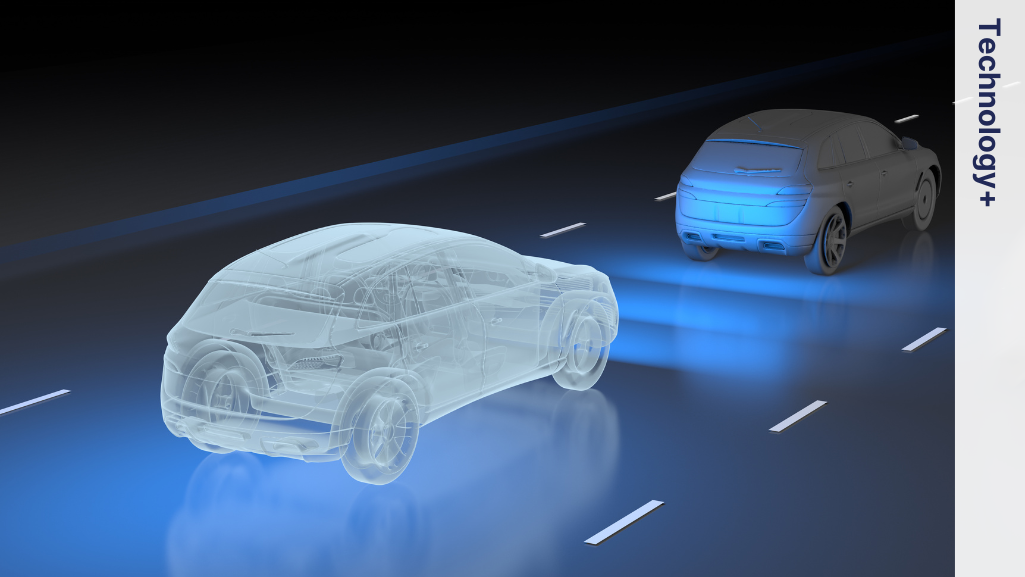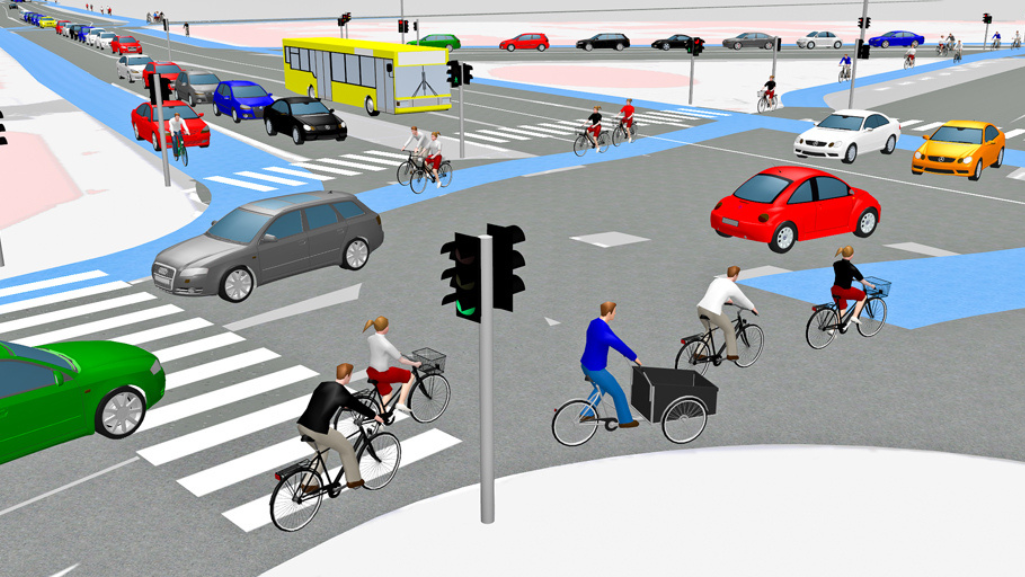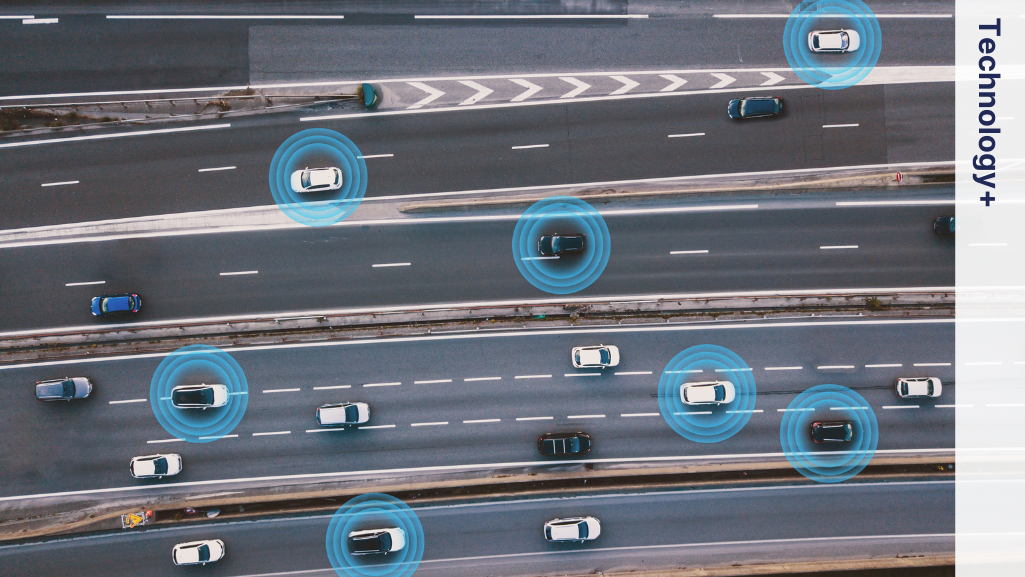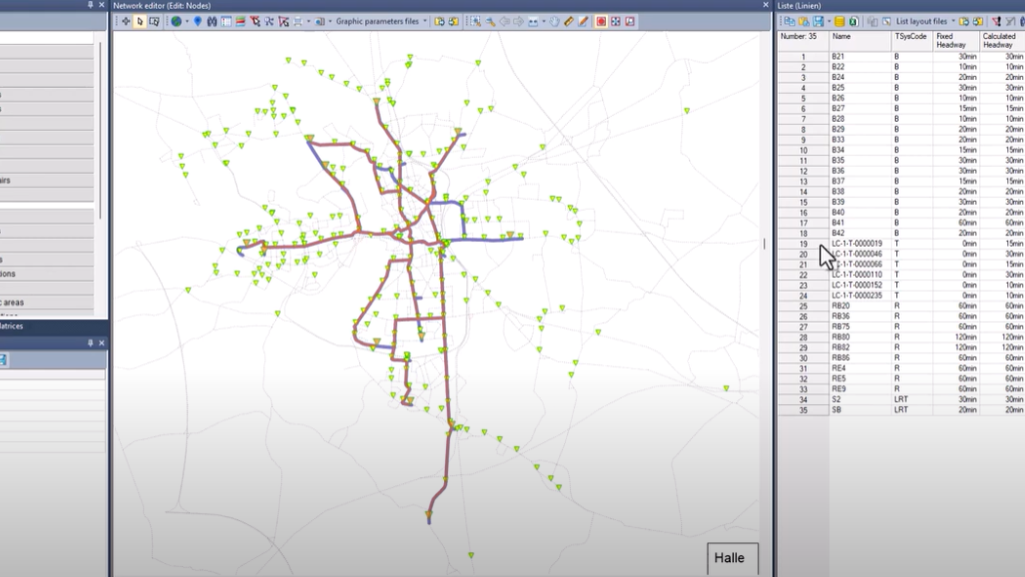Microscopic traffic simulation lives from the interaction of individual traffic participants (pedestrians, cyclists, vehicles etc.) with each other, the traffic network and the rule set (including e.g. signal control). These interactions happen on basis of decisions of each traffic participant. The underlying basis for these decisions is given through driving behavior models. So, the driving behavior model is a key element of each microscopic simulation and a crucial factor to achieve highest realism.
The driving behavior models in PTV Vissim can basically be grouped into lane-based traffic behavior, where each vehicle stays within the borders of a given lane and non-lane-based behavior, where the whole width of the roadway is used to accommodate vehicles as we can observe for example in some South East Asian countries.
For lane-based behavior, we differentiate between the car following model and the lane change model. Both can be widely parametrized in order to calibrate the simulation to the different driving styles and traffic conditions around the world. A rather aggressive traffic for example will – in contrast to a rather comfort oriented traffic – have higher accelerations and decelerations, lower safety distances, a higher acceptance to slow down other vehicles as result of lane change etc. With the right parametrization, PTV Vissim provides an accurate representation of the real-world traffic situation. It can be used to determine and optimize the capacity of the transport system and road infrastructure e.g. through improved signal control or to assess the influence of new technologies like Car2X-communication or automated driving.
Strong Scientific Background
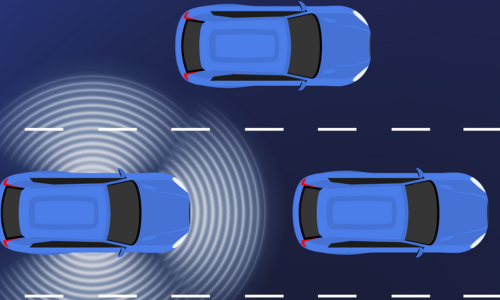
The car following models in PTV Vissim have a strong scientific background and are based on the work of Prof. Dr.-Ing. Rainer Wiedemann. The Wiedemann Model is a so-called psycho-physical model. The goal is to represent the intention of the driver to travel at a certain desired speed while travelling “solo” or to keep a certain desired safety distance while following another vehicle. This is the psychological component. In addition, there is a physical component of the driver to be reflected.
The task of car-following is a subset of the longitudinal control of a vehicle. As an interactive driving task, it requires a constant loop of perception (of the environment), planning (of the next movement) and control (of the own vehicle).
The physical component of the car following model now maps the human component to those driving tasks. In terms of perception, a human driver can only guess the distance of his vehicle to a leading vehicle with a certain limited precision. So, there is always an error and small changes in distance are very hard to be perceived. The same is true for the speed of the leading vehicle. Here as well, human drivers can only guess the actual driving speed and small speed variations can hardly be recognized. While those two effects appear to be trivial at first glance, they have a strong influence on car following behavior. Those human imperfections in the perception of speed and distance require a constant adjustment of the speed of the own vehicle in order to compensate for the latest estimation error. In addition, there is another layer of imprecision on top: the control. Even if it was exactly clear which speed would be needed to keep the desired distance, it is virtually impossible to reach that speed through actuation with the right foot on the accelerator pedal. So, the following car is always a bit too slow or too fast and the speed needs constant adjustment. In result, vehicles don’t follow with a constant distance but rather with a certain oscillation around the target value. This effect can be seen in the following image, depicting distance over speed difference for the situation of a faster car approaching a slower leading vehicle and then going in to following mode.
The faster car (“Following Car”) approaches with higher speed (black curve in the top right) and holds the speed difference constant while it is still in the state of “free flow” [1], so without influence of the leading vehicle. Once it has reached a distance, where the slower leading vehicle is perceived as such, it enters the “approaching state” [3]. In this state, the driver constantly reduces its speed while the distance to the leading vehicle shrinks as well until the desired safety distance (psychological aspect of the model) just above the “braking state” [4] is reached. This leads to the “following state” [2] where the driver would like to follow the leading vehicle with the desired safety distance.
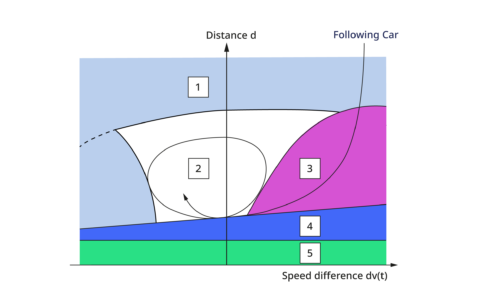
But the physical limitations described previously result in a constant slight misestimation of speed and distance of the leading vehicle and hence a continuous back and forth between approaching with a slightly too high speed and falling behind with a slightly too low speed. In results, following behavior of human drivers leads qualitatively to a spiral of continuous oscillation around a target state. For completeness, state [5] is the “collision state”, where the distance between the two front ends of the vehicles (as reference points of the model) is shorter than the length of the leading vehicle, which equals a rear-end crash.
The oscillations in car-following can be so strong and accumulate over a chain of vehicles that they can even create congestions virtually out of nowhere on highways. Of course, PTV Vissim can replicate such effects as well.
In contrast to human drivers, automated driving functions can rely on precise sensor information from RADAR or LIDAR detectors as input. They give very precise measurements of the distance to the leading vehicle, using the signal propagation time of the sensor signal, as well as the relative speed under use of the Doppler frequency shift. And the control of the car does not happen through an imprecise actuation of the accelerator pedal but directly on electronic control unit (ECU) level with a precise numeric input directly from the control algorithm. So, all the human imprecisions are suddenly eliminated from the equation and vehicles are basically able to follow precisely at the desired safety distance with only marginal error.
In order to provide the best possible representation of such precise automated car following, we are introducing a new car following model to PTV Vissim. The basis builds a generalized implementation of an Adaptive Cruise Control (ACC) logic. It is also widely parametrizable to reflect different automated driving strategies, but in any case it will reflect an algorithmic behavior without imperfection of perception or control. The qualitative difference can easily be seen in a diagram of the approach of a faster following vehicle to a slower leading vehicle. While specifically the beginning of the approach looks qualitatively the same to a human controlled vehicle, the difference becomes apparent when the desired distance is reached and the faster vehicle has closed the gap and is essentially only following. Instead of a constant loop around a target value, the following vehicle under algorithmic control just asymptotically approaches the desired safety distance and then remains there at a constant distance with a speed identical to the leading vehicle (given that the leading vehicle travels at a constant speed).
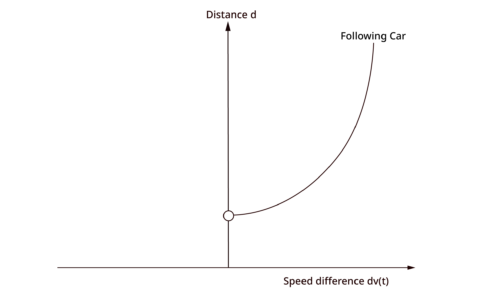
In addition, to complete the following behavior to a full driving behavior, we also introduce an automated lane change behavior on basis of the implementation of an Automatic Lane Change (ALC) algorithm. Again, a set of variables allows for a wide parametrization of the lane change behavior to represent different styles of automated driving.
Through parametrization the new driving behavior is capable of representing various stages of automation starting from SAE Level 1, e.g. with only ACC active up to SAE Level 5, full automation under all conditions. As the proportion of vehicles in an automated driving state will rise constantly in the next years, PTV Vissim users can now easily set up mixed fleets in the simulation by applying a mixture of automated ACC/ALC vehicles and human-driven Wiedemann vehicles. The simulation provides the ideal environment to assess the traffic impact of different automation strategies including Car2X communication or even to work as a digital proving ground to develop and validate automated driving functions of external models in order to achieve safe operation under all conditions.
